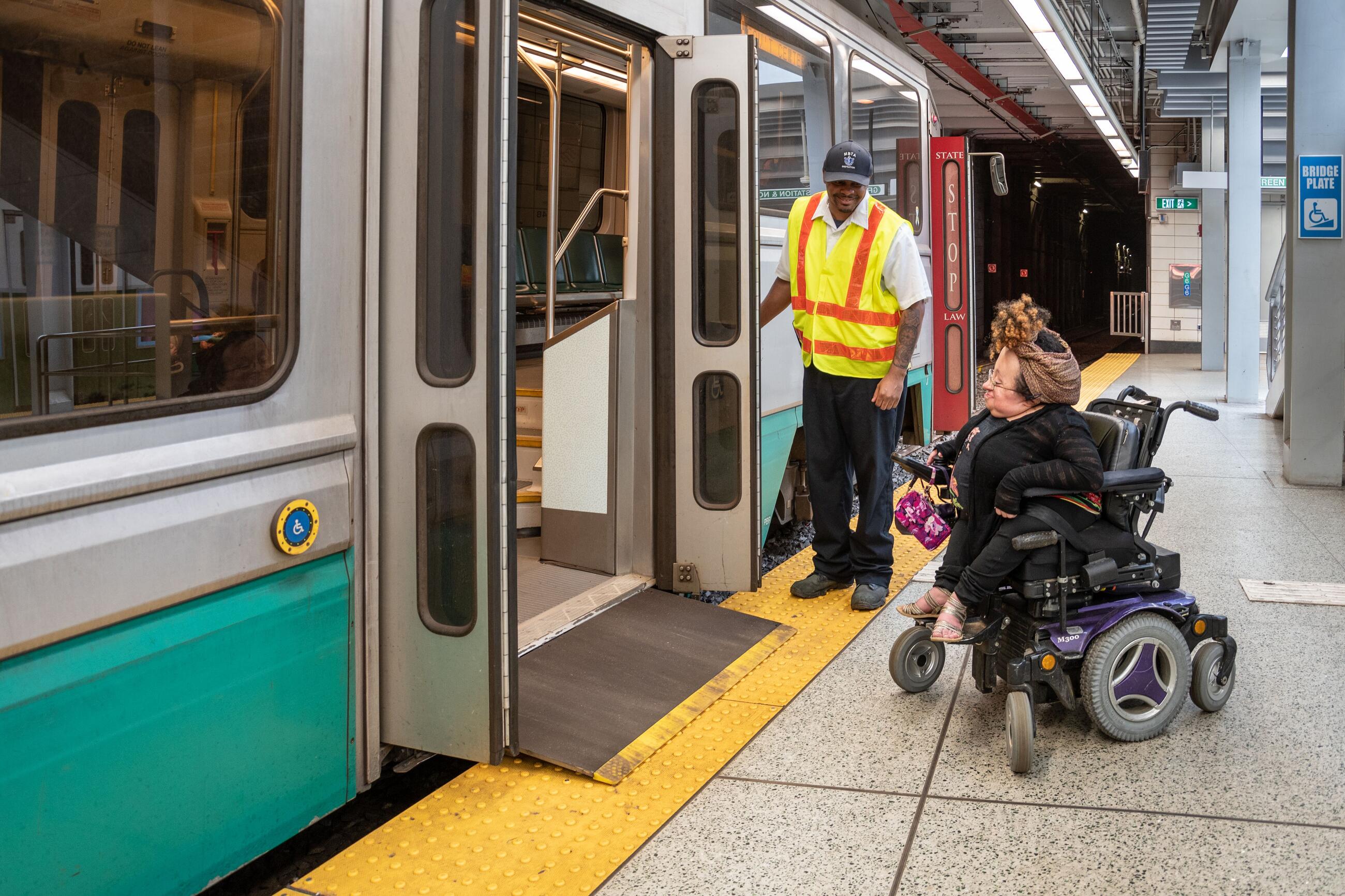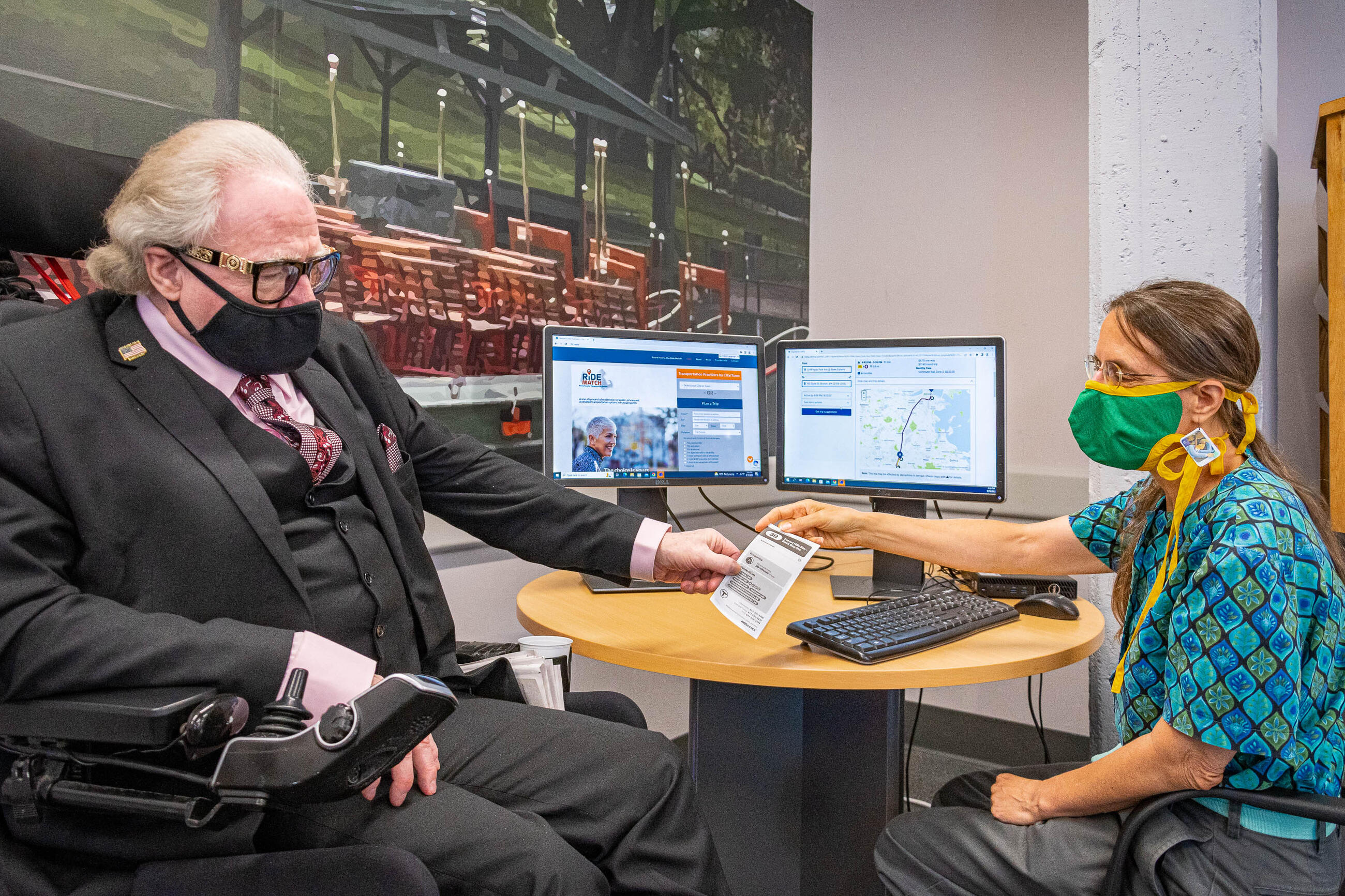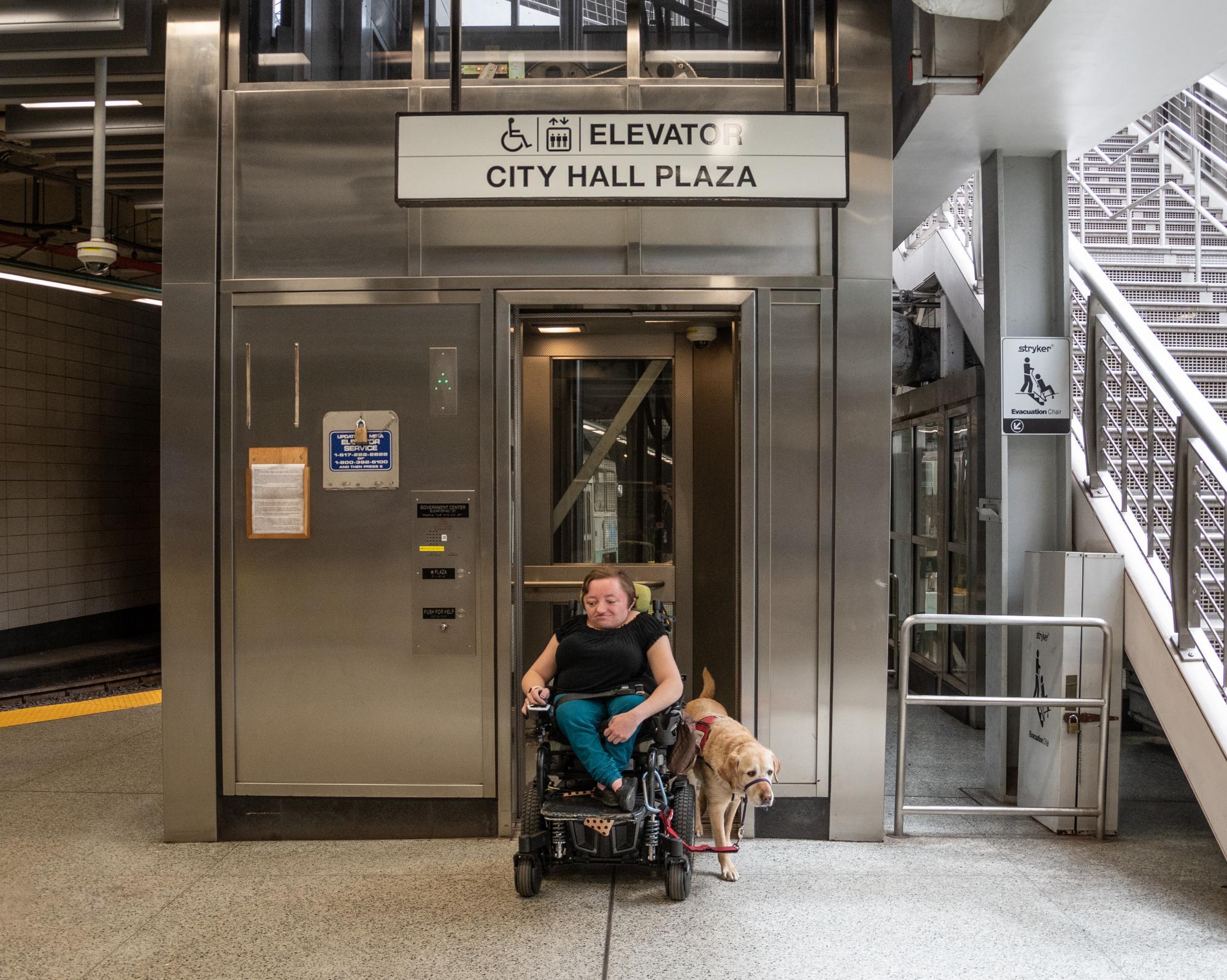Accessibility Improvements

The MBTA is more accessible than ever.
Over the past decade, we’ve made thousands of improvements, including the following:
- Constructed more than 75 new station elevators, with another 55 to come
- Added 1,000 accessible buses to our fleet featuring ramps at every front door, a reconfigured seating layout providing riders with more space, and clear, reliable stop announcements
- Started rolling out new subway cars—our most accessible yet—on multiple lines
- Installed automated door openers at every subway station
- Launched initiatives to improve operator trainings, rider resources, community outreach, and design and policy standards
There's much more to come. The MBTA is committed to building a fully accessible system, and we’ve been hard at work developing our Plan for Accessible Transit Infrastructure (PATI)—a roadmap for the improvements that will help us get there.
Identifying Accessibility Barriers
It’s easy to identify our biggest barriers, such as inaccessible stations and stops. But, to achieve full accessibility, we need to identify the other meaningful barriers that can make using the MBTA more challenging.
From 2017 – 2018, the Department of System-Wide Accessibility (SWA) surveyed every MBTA station and stop to catalog barriers such as missing curb ramps, heavy station doors, and obstructions in the path of travel.
The effort has yielded extensive data about the types and locations of access barriers throughout the system. We can’t fix everything at once, so we’ve worked with outside groups who have helped prioritize the improvements we want to make.
- (Former) Access Advisory Committee to the T (AACT)
- Boston Center for Independent Living (BCIL)
- Daniels-Finegold vs. MBTA Plaintiffs
- Disability Policy Consortium (DPC)
- Greater Boston Legal Services (GBLS)
- Massachusetts Office on Disability (MOD)
- Mass Senior Action Council (MSAC)
- Massachusetts Institute for Technology (MIT)
- Riders’ Transportation Access Group (R-TAG)
- Transportation for Massachusetts (T4MA)
- WalkBoston
How We Set Priorities
Many factors go into setting priorities for what, where, and when accessibility improvements should be made across the system. These include:
- Overall ridership at a given station or stop
- The number of seniors and people with disabilities living in the area
- The severity of existing barriers
- An improvement's "readiness"—how quickly and easily it could be implemented, either on its own or as part of another ongoing infrastructure project
Different needs may emerge over time, and some priorities we’ve set through PATI may change, but our commitment to a fully accessible system will not.
The Mobility Center Can Help You Choose How to Ride

The Mobility Center, located in Boston at 1000 Massachusetts Ave, can help you plan trips, apply for reduced fare passes, sign up for The RIDE, and more.
Mode-Specific Plans
The current state of accessibility varies across our transit modes, as do our plans to achieve 100% accessibility in all our transit stops, stations, and services.
Bus Stops
While 100% of MBTA buses are accessible, all of our bus stops are not. We’re working to change that.
We have 7,690 MBTA bus stops, and approximately 10% of them have two or more significant barriers to access.
In 2017 and 2018, we collected data on all bus stops to identify accessibility barriers, such as unusable curb ramps and narrow or uneven sidewalks. We found that 84% of stops had at least one barrier within the stop or on the path to the nearest crosswalk. For example:
- 20% had sidewalks narrower than four feet wide for the full length of the stop
- 6% had sidewalks narrower than 36 inches
- 18% had landing pads too narrow to allow a bus ramp to easily deploy
- 14% were located near crossings with missing curb ramps
To identify priorities for each stop, we grouped them into four categories:
- Critical (3%): These stops were fundamentally inaccessible, with no curb ramp or access to or from the stop—riders using wheeled mobility devices had no choice but to board or exit from the street
- High priority (9%): These stops had two or more significant access barriers within or between the stop and the nearest crossing
- Medium priority (75%): These stops had one significant access barrier
- Low priority (13%): These stops had negligible or no barriers
Please note that if any obstacles are present at a bus stop, our operators are trained to stop the bus at a nearby accessible location.
We identified 280 critical stops. 99 of which were permanently closed due to extremely low ridership, and roughly 181 that needed complete reconstruction to be made accessible.
By mid-2023, construction on 102 stops has been completed. The remaining 29 critical stops are either under design or will be addressed as part of upcoming municipal projects. Progress has been temporarily paused at the remaining 50 stops while issues related to property abutters and/or easements are negotiated and resolved.
We have also made progress on addressing the high-priority stops:
- As of mid-2023, approximately 141 high-priority stops had been reconstructed or were under construction, and another 150 are under design.
- Additional stops will undergo continuous review as other infrastructure upgrades move forward. Accessibility improvements are one of the many components of the Better Bus Project.
It’s important to note that the vast majority of MBTA bus stops are located on municipal or privately owned sidewalks. That’s why our plan also includes sharing the data we’ve collected with cities and towns, so they can help remove remaining access barriers from stops across the network.
Green Line
Of the 70 Green Line stops—underground and elevated—40 are accessible.
The Green Line is the oldest branch of the T, and one of the most challenging parts of the system to make fully accessible. Some street-level stations are along major roadways, and renovating platforms for accessibility at these locations requires significant collaboration with the City of Boston and other stakeholders.
Minor-to-moderate barriers also exist, such as heavy station doors and broken sidewalks.
| Station | Location | Status | |||
|---|---|---|---|---|---|
| Station | Amory Street, Babcock Street | Location | Status | Complete | |
| Station | Brookline Hills | Location | Status | Complete | |
| Station | Hynes Convention Center | Location |
| Status | In progress |
| Station | Newton Highlands | Location | Status | In progress | |
| Station | Symphony | Location | Status | In progress | |
| Station | Waban, Eliot, Chestnut Hill, and Beaconsfield | Location | Status | In progress | |
| Station | Brandon Hall | Location | Status | In planning stage | |
| Station | Chestnut Hill Avenue | Location | Status | In planning stage | |
| Station | Chiswick Road | Location | Status | In planning stage | |
| Station | Englewood Avenue | Location | Status | In planning stage | |
| Station | Fairbanks Street | Location | Status | In planning stage | |
| Station | Hawes Street | Location | Status | In planning stage | |
| Station | Kent Street | Location | Status | In planning stage | |
| Station | Packard's Corner | Location | Status | In planning stage | |
| Station | Saint Paul Street | Location | Status | In planning stage | |
| Station | South Street | Location | Status | In planning stage | |
| Station | Summit Avenue | Location | Status | In planning stage | |
| Station | Sutherland Road | Location | Status | In planning stage |
Orange Line
All 20 Orange Line stations are accessible.
Although all Orange Line stations are accessible, minor-to-moderate accessibility barriers still exist, such as heavy station doors and broken sidewalks.
- Construct new, secondary elevators at key locations and modernize select existing elevators
- Resolve minor-to-moderate barriers throughout the system
| Station | Location | Status | |||
|---|---|---|---|---|---|
| Station | Ruggles – Phase I | Location | Status | Complete | |
| Station | Oak Grove | Location | Status | Complete | |
| Station | Ruggles – Phase II | Location | Status | In progress | |
| Station | Downtown Crossing | Location | Status | In progress | |
| Station | Forest Hills | Location | Status | In progress |
Red Line
All 22 Red Line stations are accessible.
Since Wollaston station reopened in August 2019, all Red Line stations have been accessible. However, minor-to-moderate accessibility barriers still exist, such as heavy doors and broken sidewalks.
- Construct new, secondary elevators at key locations and modernize select existing elevators
- Resolve minor-to-moderate barriers throughout the system
| Station | Location | Status | |||
|---|---|---|---|---|---|
| Station | Downtown Crossing | Location | Status | In progress |
Blue Line
11 of the 12 Blue Line stations are accessible.
Bowdoin is the only inaccessible station on the Blue Line. Though the other 11 Blue Line stations are accessible, minor-to-moderate accessibility barriers still exist, such as heavy station doors and broken sidewalks.
- Construct new, secondary elevators at key locations and modernize select existing elevators
- Resolve minor-to-moderate barriers throughout the system
Mattapan Line
Seven of the eight Mattapan Line stations are accessible via mini-high platforms.
Valley Road is the only inaccessible station on the Mattapan Line. Although, a number of minor-to-moderate barriers exist throughout all the stations on the line, including deteriorating sidewalks and curb ramps.
We are in the process of procuring a design firm with the goal of rebuilding the Mattapan Line to make it more reliable and fully accessible. Once we receive the Type 10 cars being manufactured for the Green Line, several existing Green Line cars will replace existing Mattapan trolleys.
Commuter Rail
- Of our 142 Commuter Rail stations, 115 are accessible.
Commuter Rail trains are accessed via full-high and mini-high platforms that allow for level boarding. Just over 30 stations do not have raised platforms and are inaccessible.
- Renovate highest priority stations to provide level boarding and full accessibility
- Repair mini-high platforms as needed and install all missing tactile warnings system-wide
| Station | Location | Status | |||
|---|---|---|---|---|---|
| Station | Chelsea | Location | Status | Complete | |
| Station | Mansfield | Location | Status | Complete | |
| Station | Ruggles | Location | Status | Complete | |
| Station | Auburndale, West Newton, and Newtonville | Location | Status | In progress | |
| Station | Lynn | Location | Status | In progress | |
| Station | Natick Center | Location | Status | In progress | |
| Station | South Attleboro | Location | Status | In progress | |
| Station | Winchester Center | Location | Status | In progress | |
| Station | Worcester Union | Location | Status | In progress |
System-Wide Improvements

We often make the same type of smaller-scale accessibility improvement in multiple locations across the system. To improve efficiency, we may create dedicated programs for these improvements, or incorporate them into other T programs that address related improvements and upgrades system-wide.
Examples of improvements that fall under this category include:
- Automatic door opener installations
- Elevator installations
- Detectable warning system installations
- Accessible parking expansions and improvements
- Sidewalk, ramp, or stairway installations and repairs, and improvements to other paths of travel
- Wayfinding sign or technology improvements
Elevator and Escalator Replacements
We’re developing a plan to help us target inaccessible elevators and escalators throughout the system for replacement. Construction is already underway or complete at some of our busiest stations, while other elevator projects are in various stages of design and/or funding approval.
Learn more about elevator accessibility improvement projects
| Station | Location | Status | |||
|---|---|---|---|---|---|
| Station | Alewife (813, 814, and 815) | Location | Status | Complete | |
| Station | Andrew (857, 858, and 859) | Location | Status | Complete | |
| Station | Central (861) | Location | Status | Complete | |
| Station | Downtown Crossing (998, 999) | Location | Status | Complete | |
| Station | Forest Hills (724) | Location | Status | Complete | |
| Station | Harvard (821) | Location | Status | Complete | |
| Station | Quincy Adams (805, 806, 807) | Location | Status | Complete | |
| Station | Ruggles (728, 848, 849, 850, 851) | Location | Status | Complete | |
| Station | Arlington | Location | Status | In design stage | |
| Station | Broadway | Location | Status | In design stage | |
| Station | Central | Location | Status | In design stage | |
| Station | Chinatown | Location | Status | In design stage | |
| Station | Davis | Location | Status | In design stage | |
| Station | Downtown Crossing – Phase 2 | Location | Status | In design stage | |
| Station | Forest Hills | Location | Status | In design stage | |
| Station | Jackson Square | Location | Status | In design stage | |
| Station | Massachusetts Avenue | Location | Status | In design stage | |
| Station | North Station | Location | Status | In design stage | |
| Station | Park Street | Location | Status | In design stage | |
| Station | State Street | Location | Status | In design stage | |
| Station | Sullivan Square | Location | Status | In design stage | |
| Station | Wellington | Location | Status | In design stage |
Building a Better T
As part of our $9.6 billion, 5-year capital investment plan, we're renovating stations, modernizing fare collection systems, upgrading services for our buses, subways, and ferries, and improving the accessibility of the entire system.
Recent Updates
Accessible Technology
Stay Informed
Get accessibility news, updates, and advance notice of events delivered to your inbox.
The Mobility Center Can Help You Choose How to Ride

The Mobility Center, located in Boston at 1000 Massachusetts Ave, can help you plan trips, apply for reduced fare passes, sign up for The RIDE, and more.
Building a Better T
As part of our $9.6 billion, 5-year capital investment plan, we're renovating stations, modernizing fare collection systems, upgrading services for our buses, subways, and ferries, and improving the accessibility of the entire system.



